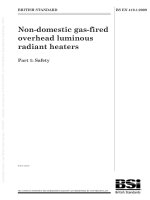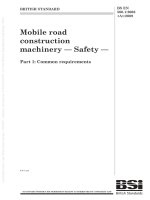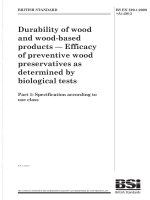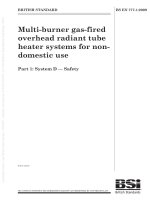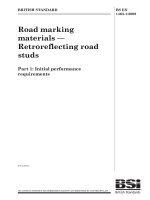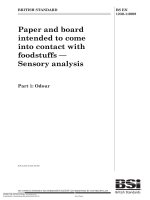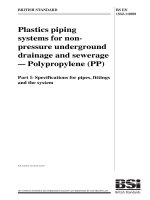Bsi bs en 62137 1 5 2009
Bạn đang xem bản rút gọn của tài liệu. Xem và tải ngay bản đầy đủ của tài liệu tại đây (1.73 MB, 28 trang )
BS EN 62137-1-5:2009
BSI British Standards
Surface mounting technology —
Environmental and endurance
test methods for surface mount
solder joints —
Part 1-5: Mechanical shear fatigue test
NO COPYING WITHOUT BSI PERMISSION EXCEPT AS PERMITTED BY COPYRIGHT LAW
raising standards worldwide™
BRITISH STANDARD
BS EN 62137-1-5:2009
National foreword
This British Standard is the UK implementation of EN 62137-1-5:2009. It is
identical to IEC 62137-1-5:2009.
The UK participation in its preparation was entrusted to Technical Committee
EPL/501, Electronic assembly technology.
A list of organizations represented on this committee can be obtained on
request to its secretary.
This publication does not purport to include all the necessary provisions of a
contract. Users are responsible for its correct application.
© BSI 2009
ISBN 978 0 580 59253 9
ICS 31.190
Compliance with a British Standard cannot confer immunity from
legal obligations.
This British Standard was published under the authority of the Standards
Policy and Strategy Committee on 31 July 2009
Amendments issued since publication
Amd. No.
Date
Text affected
EUROPEAN STANDARD
EN 62137-1-5
NORME EUROPÉENNE
May 2009
EUROPÄISCHE NORM
ICS 31.190
English version
Surface mounting technology Environmental and endurance test methods
for surface mount solder joints Part 1-5: Mechanical shear fatigue test
(IEC 62137-1-5:2009)
Technologie du montage en surface Méthodes d'essais d'environnement
et d'endurance des joints brasés
montés en surface Partie 1-5: Essai de fatigue
par cisaillement mécanique
(CEI 62137-1-5:2009)
Oberflächenmontage-Technik Verfahren zur Prüfung
auf Umgebungseinflüsse
und zur Prüfung der Haltbarkeit
von Oberflächen-Lötverbindungen Teil 1-5: Prüfung der Ermüdung durch
mechanische Scherbeanspruchung
(IEC 62137-1-5:2009)
This European Standard was approved by CENELEC on 2009-04-01. CENELEC members are bound to comply
with the CEN/CENELEC Internal Regulations which stipulate the conditions for giving this European Standard
the status of a national standard without any alteration.
Up-to-date lists and bibliographical references concerning such national standards may be obtained on
application to the Central Secretariat or to any CENELEC member.
This European Standard exists in three official versions (English, French, German). A version in any other
language made by translation under the responsibility of a CENELEC member into its own language and notified
to the Central Secretariat has the same status as the official versions.
CENELEC members are the national electrotechnical committees of Austria, Belgium, Bulgaria, Cyprus, the
Czech Republic, Denmark, Estonia, Finland, France, Germany, Greece, Hungary, Iceland, Ireland, Italy, Latvia,
Lithuania, Luxembourg, Malta, the Netherlands, Norway, Poland, Portugal, Romania, Slovakia, Slovenia, Spain,
Sweden, Switzerland and the United Kingdom.
CENELEC
European Committee for Electrotechnical Standardization
Comité Européen de Normalisation Electrotechnique
Europäisches Komitee für Elektrotechnische Normung
Central Secretariat: avenue Marnix 17, B - 1000 Brussels
© 2009 CENELEC -
All rights of exploitation in any form and by any means reserved worldwide for CENELEC members.
Ref. No. EN 62137-1-5:2009 E
BS EN 62137-1-5:2009
EN 62137-1-5:2009
–2–
Foreword
The text of document 91/826/FDIS, future edition 1 of IEC 62137-1-5, prepared by IEC TC 91, Electronics
assembly technology, was submitted to the IEC-CENELEC parallel vote and was approved by CENELEC
as EN 62137-1-5 on 2009-04-01.
The following dates were fixed:
– latest date by which the EN has to be implemented
at national level by publication of an identical
national standard or by endorsement
(dop)
2010-01-01
– latest date by which the national standards conflicting
with the EN have to be withdrawn
(dow)
2012-04-01
Annex ZA has been added by CENELEC.
__________
Endorsement notice
The text of the International Standard IEC 62137-1-5:2009 was approved by CENELEC as a European
Standard without any modification.
In the official version, for Bibliography, the following notes have to be added for the standards indicated:
IEC 60068-2-21
NOTE Harmonized as EN 60068-2-21:2006 (not modified).
IEC 61188-5-8
NOTE Harmonized as EN 61188-5-8:2008 (not modified).
__________
–3–
BS EN 62137-1-5:2009
EN 62137-1-5:2009
Annex ZA
(normative)
Normative references to international publications
with their corresponding European publications
The following referenced documents are indispensable for the application of this document. For dated
references, only the edition cited applies. For undated references, the latest edition of the referenced
document (including any amendments) applies.
NOTE When an international publication has been modified by common modifications, indicated by (mod), the relevant EN/HD
applies.
Publication
Year
Title
EN/HD
Year
Environmental testing Part 1: General and guidance
EN 60068-1
1994
2)
Printed board design, manufacture and
assembly - Terms and definitions
EN 60194
2006
2)
IEC 60068-1
-
1)
IEC 60194
-
1)
IEC 61188-5
Series Printed boards and printed board
EN 61188-5
assemblies - Design and use Part 5: Attachment (land/joint) considerations
IEC 61190-1-2
2007
IEC 61190-1-3
-
IEC 61249-2-7
2002
IEC 61760-1
-
1)
2)
1)
1)
Undated reference.
Valid edition at date of issue.
Attachment materials for electronic
assembly Part 1-2: Requirements for soldering pastes
for high-quality interconnects in electronics
assembly
EN 61190-1-2
Series
2007
www.bzfxw.com
EN 61190-1-3
Attachment materials for electronic
assembly Part 1-3: Requirements for electronic grade
solder alloys and fluxed and non-fluxed solid
solders for electronic soldering applications
Materials for printed boards and other
interconnecting structures Part 2-7: Reinforced base materials, clad
and unclad - Epoxide woven E-glass
laminated sheet of defined flammability
(vertical burning test), copper-clad
EN 61249-2-7
+ corr. September
Surface mounting technology EN 61760-1
Part 1: Standard method for the specification
of surface mounting components (SMDs)
2007
2)
2002
2005
2006
2)
BS EN 62137-1-5:2009
–2–
62137-1-5 © IEC:2009
CONTENTS
FOREWORD...........................................................................................................................3
INTRODUCTION.....................................................................................................................5
1
Scope ...............................................................................................................................6
2
Normative references .......................................................................................................7
3
Terms and definitions .......................................................................................................8
4
Test equipment and materials...........................................................................................8
5
4.1 Test equipment for mechanical shear fatigue testing ............................................... 8
4.2 Test substrate .........................................................................................................8
4.3 Solder alloy .............................................................................................................9
4.4 Solder paste ............................................................................................................9
4.5 Reflow soldering equipment ....................................................................................9
Mounting ..........................................................................................................................9
6
Test conditions ............................................................................................................... 10
7
6.1 Pre-treatment ........................................................................................................ 10
6.2 Test procedures .................................................................................................... 10
6.3 Judging criteria...................................................................................................... 10
Items to be included in the test report ............................................................................. 11
8
Items to be given in the product specification ................................................................. 11
Annex A (normative) Mechanical shear fatigue test equipment............................................. 12
www.bzfxw.com
Annex B (normative) Mechanical shear fatigue test procedure ............................................. 15
Annex C (informative) Evaluation of mechanical properties of a single solder joint by
mechanical shear fatigue test ............................................................................................... 17
Bibliography.......................................................................................................................... 21
Figure 1 – Image drawing on evaluation area of joint strength.................................................6
Figure 2 – Schematic illustrations of thermomechanical and mechanical fatigue for
solder joints ............................................................................................................................7
Figure 3 – A typical temperature profile taken by reflow soldering equipment........................ 10
Figure A.1 – Sample structures of shear fatigue jig ............................................................... 13
Figure B.1 – Example of set-up for electrical resistance measuring....................................... 16
Figure C.1 – Schematic illustration of the single solder joint for mechanical fatigue
testing .................................................................................................................................. 18
Figure C.2 – Schematic illustration of fixing jig for soldering of the single solder joint ........... 18
Figure C.3 – Schematic illustration of the shear fatigue jig .................................................... 19
Figure C.4 – Relationship between reaction forces and the number of cycles during a
fatigue test............................................................................................................................ 20
Figure C.5 – Relationship between the displacement range and fatigue life .......................... 20
BS EN 62137-1-5:2009
62137-1-5 © IEC:2009
–3–
INTERNATIONAL ELECTROTECHNICAL COMMISSION
____________
SURFACE MOUNTING TECHNOLOGY –
ENVIRONMENTAL AND ENDURANCE TEST METHODS
FOR SURFACE MOUNT SOLDER JOINTS –
Part 1-5: Mechanical shear fatigue test
FOREWORD
1) The International Electrotechnical Commission (IEC) is a worldwide organization for standardization comprising
all national electrotechnical committees (IEC National Committees). The object of IEC is to promote
international co-operation on all questions concerning standardization in the electrical and electronic fields. To
this end and in addition to other activities, IEC publishes International Standards, Technical Specifications,
Technical Reports, Publicly Available Specifications (PAS) and Guides (hereafter referred to as “IEC
Publication(s)”). Their preparation is entrusted to technical committees; any IEC National Committee interested
in the subject dealt with may participate in this preparatory work. International, governmental and nongovernmental organizations liaising with the IEC also participate in this preparation. IEC collaborates closely
with the International Organization for Standardization (ISO) in accordance with conditions determined by
agreement between the two organizations.
2) The formal decisions or agreements of IEC on technical matters express, as nearly as possible, an international
consensus of opinion on the relevant subjects since each technical committee has representation from all
interested IEC National Committees.
3) IEC Publications have the form of recommendations for international use and are accepted by IEC National
Committees in that sense. While all reasonable efforts are made to ensure that the technical content of IEC
Publications is accurate, IEC cannot be held responsible for the way in which they are used or for any
misinterpretation by any end user.
www.bzfxw.com
4) In order to promote international uniformity, IEC National Committees undertake to apply IEC Publications
transparently to the maximum extent possible in their national and regional publications. Any divergence
between any IEC Publication and the corresponding national or regional publication shall be clearly indicated in
the latter.
5) IEC provides no marking procedure to indicate its approval and cannot be rendered responsible for any
equipment declared to be in conformity with an IEC Publication.
6) All users should ensure that they have the latest edition of this publication.
7) No liability shall attach to IEC or its directors, employees, servants or agents including individual experts and
members of its technical committees and IEC National Committees for any personal injury, property damage or
other damage of any nature whatsoever, whether direct or indirect, or for costs (including legal fees) and
expenses arising out of the publication, use of, or reliance upon, this IEC Publication or any other IEC
Publications.
8) Attention is drawn to the Normative references cited in this publication. Use of the referenced publications is
indispensable for the correct application of this publication.
9) Attention is drawn to the possibility that some of the elements of this IEC Publication may be the subject of
patent rights. IEC shall not be held responsible for identifying any or all such patent rights.
International Standard IEC 62137-1-5 has been prepared by IEC technical committee 91:
Electronics assembly technology.
The text of this standard is based on the following documents:
FDIS
Report on voting
91/826/FDIS
91/841/RVD
Full information on the voting for the approval of this standard can be found in the report on
voting indicated in the above table.
This publication has been drafted in accordance with the ISO/IEC Directives, Part 2.
BS EN 62137-1-5:2009
–4–
62137-1-5 © IEC:2009
A list of all parts of the IEC 62137 series, under the general title Surface mounting
technology – Environmental and endurance test methods for surface mount solder joints, can
be found on the IEC website.
The committee has decided that the contents of this publication will remain unchanged until
the maintenance result date indicated on the IEC web site under "" in
the data related to the specific publication. At this date, the publication will be
•
•
•
•
reconfirmed,
withdrawn,
replaced by a revised edition, or
amended.
www.bzfxw.com
BS EN 62137-1-5:2009
62137-1-5 © IEC:2009
–5–
INTRODUCTION
The mechanical properties of lead-free solder joints between leads and lands on a printed
wiring board are not the same with tin-lead-containing solder joints, due to their solder
compositions. Thus, it becomes important to test the mechanical properties of solder joints of
different alloys.
www.bzfxw.com
BS EN 62137-1-5:2009
62137-1-5 © IEC:2009
–6–
SURFACE MOUNTING TECHNOLOGY –
ENVIRONMENTAL AND ENDURANCE TEST METHODS
FOR SURFACE MOUNT SOLDER JOINTS –
Part 1-5: Mechanical shear fatigue test
1 Scope
The test method described in this part of IEC 62137 applies to area array packages, such as
BGA. This test method is designed to evaluate the fatigue life of the solder joints between
component leads and lands on a substrate as shown in Figure 1. A temperature cyclic
approach is generally used to evaluate the reliability of solder joints. Another method is to
mechanically cycle the solder joints to shorten the testing time rather than to produce the
strains by changing temperatures. The methodology is the imposition of shear deformation on
the solder joints by mechanical displacement instead of relative displacement generated by
CTE (coefficient of thermal expansion) mismatch, as shown in Figure 2. In place of the
temperature cycle test, the mechanical shear fatigue predicts the reliability of the solder joints
under repeated temperature change conditions by mechanically cycling the solder joints. In
this test method, the evaluation requires first to mount the surface mount component on the
substrate by reflow soldering, then cyclic mechanical shear deformation is applied to the
solder joints until fracture of the solder joints occurs. The properties of the solder joints (for
example solder alloy, substrate, mounted device or design, etc.) are evaluated to assist in
improving the strength of the solder joints.
www.bzfxw.com
NOTE This test, however, does not measure the strength of the electronic components. The test method to
evaluate the robustness of the joint to a board is described in IEC 60068-2-21.
Component
land
Enlarge
Component
Substrate
Solder
Plated layers
Intermetallic compound
layers
Evaluation area
Substrate
Substrate land
IEC 232/09
Figure 1 – Image drawing on evaluation area of joint strength
BS EN 62137-1-5:2009
62137-1-5 © IEC:2009
–7–
Thermomechanical fatigue
Package
Solder
L
Δd/2
L + Δd
Δd/2
IEC 233/09
Δd = L × (αsubstrate – αpackage) × ΔT
Mechanical fatigue
Package
Solder
Mechanical loading
Δd/2
L
L + Δd
Δd/2
Mechanical loading
IEC 234/09
Key
Δd
Relative displacement
ΔT
Temperature range
α
Coefficient of thermal expansion
www.bzfxw.com
Figure 2 – Schematic illustrations of thermomechanical
and mechanical fatigue for solder joints
2
Normative references
The following referenced documents are indispensable for the application of this document.
For dated references, only the edition cited applies. For undated references, the latest edition
of the referenced document (including any amendments) applies.
IEC 60068-1, Environmental testing – Part 1: General and guidance
IEC 61188-5 (all parts), Printed boards and printed board assemblies – Design and use
IEC 60194, Printed board design, manufacture and assembly – Terms and definitions
IEC 61190-1-2:2007, Attachment materials for electronic assembly – Part 1-2: Requirements
for soldering pastes for high-quality interconnects in electronics assembly
IEC 61190-1-3, Attachment materials for electronic assembly – Part 1-3: Requirements for
electronic grade solder alloys and fluxed and non-fluxed solid solders for electronic soldering
applications
IEC 61249-2-7:2002, Materials for printed boards and other interconnecting structures –
Part 2-7: Reinforced base materials clad and unclad – Epoxide woven E-glass laminated
sheet of defined flammability (vertical burning test), copper-clad
IEC 61760-1, Surface mounting technology – Part 1: Standard method for the specification of
surface mounting components (SMDs)
BS EN 62137-1-5:2009
–8–
3
62137-1-5 © IEC:2009
Terms and definitions
For the purposes of this document, the terms and definitions given in IEC 60068-1, in
IEC 60194, as well as the following apply.
3.1
mechanical shear fatigue life
number of cycles to attain the joint fracture between surface mount component terminals
mounted on the printed board and the copper land of the substrate after application of cyclic
mechanical shear deformation
3.2
ramp rate
moving velocities of the fixing jig attached to the actuator of the mechanical testing machine
3.3
displacement range
distance between the maximum and the minimum test position caused by pushing and pulling
the actuator back, which means relative displacement in shear direction between the surface
mount component and the substrate
3.4
maximum and minimum forces
reaction forces at the maximum and minimum test positions caused by shear deformation of
the solder joint at each cycle
4
Test equipment and materials
www.bzfxw.com
4.1 Test equipment for mechanical shear fatigue testing
The equipment for mechanical shear testing consists of a tension-compression testing
machine, sample fixing jigs, a resistance-measuring instrument and a recorder. The
specifications shall be in compliance with those of the mechanical test equipment prescribed
in Annex A.
4.2
Test substrate
Unless otherwise stated in the relevant product specifications, the test substrate shall satisfy
the following conditions.
a) Material: Epoxide woven glass fabric copper-clad laminated sheet, general purpose grade
(IEC 61249-2-7:2002), with foil bonded to one side and a nominal thickness of the sheet,
including the metal foil, of 1,6 mm with a tolerance of ±0,20 mm. The copper foil shall have
a thickness of 0,035 mm ± 0,010 mm.
b) Size: The size of the substrate depends on the size and shape of a surface mount device
soldered on the substrate. The substrate shall be able to be fastened to the mechanical
shear fatigue test equipment.
c) Land geometry: The shape and size of a land shall comply with IEC 61188-5 (all parts) or
the pad geometry recommended by the respective component supplier.
d) Surface protection: The solderable areas of the substrate (lands) shall be protected
against oxidization by suitable means, for example by an organic surface protection layer
(OSP), or other finishes. This protective layer shall not have an adverse effect on the
solderability of the lands under the soldering conditions of the reflow soldering equipment.
BS EN 62137-1-5:2009
62137-1-5 © IEC:2009
4.3
–9–
Solder alloy
Unless otherwise specified, the solder alloy shall consist of a ternary composition of Sn, Ag
and Cu with 3,0 wt. % to 4,0 wt. % Ag and 0,5 wt. % to 1,0 wt. % Cu with Sn for balancing, for
example Sn96,5Ag3,0Cu0,5. The solder alloy shall be in accordance with IEC 61190-1-3.
4.4
Solder paste
Unless otherwise stated in the relevant product specifications, solder paste should be chosen
from IEC 61190-1-2. However, the solder to be used shall be the one that is specified in 4.3
above.
4.5
Reflow soldering equipment
Unless otherwise stated in the relevant product specifications, reflow-soldering equipment
should be the one that can realize the temperature profile as shown in Figure 3.
5
Mounting
Unless otherwise stated in the relevant product specifications, the surface mount component
shall be mounted on the substrate in the following sequence.
The following steps shall be taken.
a) Apply the solder paste specified in 4.4 to the lands of a test substrate as specified in 4.2,
using a stainless steel mask that has openings of the same size, shape and configuration
as the lands as specified in item c) of 4.2 with a thickness of 100 μm to 150 μm.
www.bzfxw.com
b) Mount the test specimen on the test substrate with the printed solder paste.
c) Perform soldering using the reflow soldering equipment specified in 4.5 and the solder
paste specified in 4.4 with the following conditions. Typical temperature profile of reflow
soldering is given in Figure 3 and as proposed in IEC 61760-1. The temperature shall be
measured at the land.
BS EN 62137-1-5:2009
62137-1-5 © IEC:2009
– 10 –
300
SnAgCu Reflow
250 °C
245 °C
235 °C
220 °C
Temperature °C
250
200
180 °C
Preheating
ca 45 s … 90 s > 220 °C
150 °C
150
Typical
Ramp down rate < 6 k/s
100
Ramp up rate < 3 k/s
50
0
0
30
60
90
120
150
180
210
Time s
240
270
300
330
360
Continous line: typical process (terminal temperaure)
Dotted line: process limits. Bottom process limit (terminal temperature). Upper process limit (top surface temperature)
IEC 1176/07
www.bzfxw.com
Figure 3 – A typical temperature profile taken by reflow soldering equipment
6
6.1
Test conditions
Pre-treatment
Unless otherwise stated in the relevant product specifications, leave the specimen under
standard atmospheric conditions (specified in IEC 60068-1) for 4 h or more.
6.2
Test procedures
Unless otherwise stated in the relevant product specifications, the following procedures
should be followed. The detail of the mechanical shear fatigue test procedures is prescribed
in Annex B.
a) Fix the test sample to the fixing jig.
b) Ramp rate, allowable displacement range and test temperature shall be set.
c) Continue the mechanical shear fatigue tests at each level in the selected displacement
range until the maximum force decreases to a certain value or the electrical resistancemeasuring instrument can detect electric continuity interruption. Make a record of the
number of cycles at fatigue life.
d) Make analytical observations of the fractured parts, as needed, verify the fracture mode
and record it.
6.3
Judging criteria
When the maximum force decreases to a certain value, for example a 20 % drop from the
initial value, or a momentary interruption detector detects that electrical continuity interruption
has occurred in the specimen, it shall be judged as fatigue life.
The result obtained by the methods described in Annex A and Annex B shows the average
measures for all the joints of the component mounted on the test specimen, including the
BS EN 62137-1-5:2009
62137-1-5 © IEC:2009
– 11 –
influences of the component and substrate with respect to fatigue life. Annex C describes the
test procedure for evaluating the mechanical shear fatigue life of a single solder joint which is
effective for eliminating the effects of the component and substrate on the fatigue life.
7
Items to be included in the test report
When a test report is required, agreement shall be made between the reporting party and the
recipient on the selection of reporting items from the following:
a) test date;
b) location of the test organization;
c) name of the electronic component, type, size, body dimensions and lead pitch;
d) base materials of lead on electronic components; and with or without plating, and
materials of plating;
e) materials of the test substrate, dimensions and layer structure;
f)
measurements of the land on the substrate and materials for the surface treatment;
g) type of solder and type of solder paste;
h) temperature profile of reflow soldering and soldering ambience (for the case of a nitrogen
ambient atmosphere, oxygen concentration should apply);
i)
model of the tensile and compression machine;
j)
details of the substrate bending jig (drawing is preferable);
k) specifications of the electrical resistance-measuring instrument;
l)
specifications of the recorder;
m) displacement rate;
www.bzfxw.com
n) displacement range and the number of cycles to fracture initiation;
o) fracture mode (photos, etc.).
8
Items to be given in the product specification
The following items shall be included:
a) test substrate (4.2);
b) solder alloy (4.3);
c) solder paste (4.4);
d) reflow soldering equipment (4.5);
e) mounting (Clause 5);
f)
pre-treatment (6.1);
g) test procedures (6.2).
BS EN 62137-1-5:2009
– 12 –
62137-1-5 © IEC:2009
Annex A
(normative)
Mechanical shear fatigue test equipment
A.1
Application
This annex applies to the test equipment for mechanical shear fatigue specified in 4.1 and
specifies the requirements.
A.2
Mechanical shear test equipment
A.2.1
Tension-compression testing machine
Unless otherwise stated in the relevant product specifications, the mechanical shear fatigue
test machine shall satisfy the following requirements.
a) This machine needs the capability of actuating the sample fixing jigs to the prescribed
displacement range (±0,001 mm to ±0,1 mm) with the use of triangular waves at the
prescribed speed (0,001 mm/s to 0,01 mm/s).
NOTE 1 In order to control displacement within a fine range, a linear DC motor or a piezo actuator is
recommended for the actuator of the machine.
NOTE 2 As the test is effective with sine and trapezoid waves instead of triangular waves, the test machine
should also be able to function with sine and trapezoid waves.
www.bzfxw.com
b) This test machine also needs the capability of measuring the prescribed displacement in
the neighborhood of the sample by using a displacement sensor attached to the sample
fixing jigs (not using displacement sensor in the actuator), and the capability of controlling
the actuator by using the displacement (feedback control). An eddy current type,
capacitance type or laser type displacement sensor is recommended.
c) The test machine should be able to measure and record elapsed cycle and time, as well
as the reaction forces generated by shear deformation of the solder joint in the course of
the fatigue test using a load cell.
d) The load cell needs the capability of measuring the reduction of the reaction force caused
by degradation of the solder joint (crack initiation and propagation).
e) The test machine should be able to control test temperature, if the test is performed with
raised temperature.
A.2.2
A.2.2.1
Shear fatigue jig
General
The shear fatigue jigs should be able to fix the sample and to impose shear deformation on
the solder joints by mechanical displacement between the component and substrate. There
are two types of load-applying methods for the shear fatigue test as shown in Figure A.1.
Unless otherwise stated in the relevant product specifications, these jigs shall meet the
following conditions.
BS EN 62137-1-5:2009
62137-1-5 © IEC:2009
– 13 –
Component
Screw
Solder
Load cell
Substrate
Actuator
Target of displacement sensor
Displacement sensor
IEC 235/09
Figure A.1a – Straddle method
Component
Solder
Actuator
Substrate
Load cell
IEC 236/09
www.bzfxw.com
Figure A.1b – Lap shear method
Figure A.1 – Sample structures of shear fatigue jig
A.2.2.1.1
Straddle fatigue method
The substrate is divided into two parts underneath the component. The divided substrates are
fastened to the jigs, and the mechanical displacement is applied to the substrate by the
actuator, resulting in the solder joint deformation in shear mode.
a) The fixture has a structure that can fasten the substrate using screws.
b) The fixture shall be designed to position the joint center at the load line to suppress
bending deformation of the sample.
c) Steel of high strength is recommended to prevent deformation due to applying a cyclic
load.
d) The displacement sensor shall be attached to the fixture to measure the displacement.
A.2.2.1.2
Lap shear method
The bottom of the substrate and the top of the component are fixed between the lap shear jigs,
and the mechanical displacement is applied to the jig by the actuator, resulting in the solder
joint deformation in shear mode.
a) The fixture has the structure that can fix the substrate to the component.
b) The fixture shall be designed to position the joint center at the load line to suppress
bending deformation of the sample.
c) Steel of high strength is recommended to prevent deformation due to applying a cyclic
load.
d) The displacement sensor shall be attached to the fixture to measure the displacement.
BS EN 62137-1-5:2009
– 14 –
A.2.3
62137-1-5 © IEC:2009
Electrical resistance measuring instrument
The electrical resistance-measuring instrument should have a mechanism to verify electrical
continuity and discontinuity on the test substrate and to be able to judge as interruption when
resistance value exceeds 1 × 10 3 Ω. In order to detect even minutes of electrical discontinuity,
a desirable instrument is one that can detect momentary continuity interruption of 10 μs to
100 μs. This instrument should have the ability to output signals so as to shut down the
tension-compression testing machine when electrical interruption is detected.
A.2.4
Recorder
The recorder is a piece of equipment that records the number of cycles with respect to fatigue
life. It is desirable that the equipment records displacement and force of the test machine
during the test.
www.bzfxw.com
BS EN 62137-1-5:2009
62137-1-5 © IEC:2009
– 15 –
Annex B
(normative)
Mechanical shear fatigue test procedure
B.1
Application
This annex applies to the test procedure for the mechanical shear fatigue specified in 6.2.
B.2
Mechanical shear fatigue test procedure
B.2.1
General
There are two types of load-applying methods for the shear fatigue test. Unless otherwise
specified by the relevant product specifications, either of the following two methods shall be
selected.
B.2.1.1
Straddle fatigue method
The straddle fatigue method is the imposition of shear deformation on the solder joints by
applying mechanical displacement to the substrate divided into two pieces.
a) Before the testing, the substrate should be divided into two parts underneath the
component.
www.bzfxw.com
b) The divided substrates are fixed to the jigs by screws. When the screws are tightened, the
reaction force should be maintained at a level of zero by means of force-controlled mode
(force feedback mode) of the testing machine in order to prevent any damage on the
solder joint.
c) The test temperature shall be set if the testing machine has a temperature control unit.
d) Ramp rate and allowable displacement range shall be set as follows.
1) The displacement rate shall be 0,005 mm/s or a speed corresponding to 0,1 Hz to
0,5 Hz.
2) The allowable displacement range shall be determined by conducting preliminary tests
for each type of the surface mount component and thereby selecting the conditions in
which joint fracture can be initiated with the cyclic number of several hundreds to
several thousands. The range corresponds to several percent of the nominal shear
strain range that is the value at which the solder joint height can be divided in
displacement.
e) Continue mechanical shear fatigue tests at each level in the selected displacement range
until the maximum force decreases to a certain value. Record the number of cycles at
fatigue life.
f)
Make analytical observations of the fractured part, as needed, verify the fracture mode
and record your observations.
B.2.1.2
Lap shear fatigue method
The lap shear fatigue method is a method in which the bottom of the substrate and the top of
the component are fixed between the lap shear jigs, and the mechanical displacement is
applied to the jig by the actuator, resulting in the solder joint deformation in shear mode.
a) Before the testing, solder the leads to the continuity monitoring terminal (daisy-chained)
on the test substrate, and then connect it to the momentary interruption detector as shown
in Figure B.1, when a component having a daisy-chain circuit is used for the testing.
BS EN 62137-1-5:2009
62137-1-5 © IEC:2009
– 16 –
b) The fixture has a structure that can fix the substrate to the component by an adhesive or
mechanically if a mechanical fixing mechanism is available in the jigs. When the specimen
is fixed to the jigs, the reaction force should be maintained at around a level of zero, by
means of force-controlled mode (force feedback mode) of the testing machine in order to
prevent any damage on the solder joint.
c) The test temperature shall be set if the testing machine has a temperature control unit.
d) The ramp rate and the allowable displacement range shall be set as follows.
1) The displacement rate shall be 0,005 mm/s or a speed corresponding to 0,1 Hz to
0,5 Hz.
2) The allowable displacement range shall be determined by conducting preliminary tests
for each type of the surface mount component and thereby selecting the conditions in
which joint fracture can be initiated with the cyclic number of several hundreds to
several thousands. The range corresponds to several percent of the nominal shear
strain range that is the value at which the displacement is divided by the solder joint
height.
e) Continue mechanical shear fatigue tests at each level in the selected displacement range
until the maximum force decreases to a certain value or the electrical resistancemeasuring instrument detects electric continuity interruption. Record of the number of
cycles at fatigue life.
f)
Make analytical observations of the fractured part, as needed, verify the fracture mode
and record your observations.
Daisy chain
Momentary
interruption
detector
www.bzfxw.com
Monitoring terminal
Component (daisy-chained circuit)
Test substrate
IEC 237/09
Figure B.1 – Example of set-up for electrical resistance measuring
BS EN 62137-1-5:2009
62137-1-5 © IEC:2009
– 17 –
Annex C
(informative)
Evaluation of mechanical properties of a single solder joint
by mechanical shear fatigue test
C.1
Application
The mechanical shear fatigue life obtained by the method described in Annexes A and B
shows the average measures for all the joints of the component mounted on the test
specimen, including the influences of the component and substrate with respect to fatigue life.
The mechanical shear fatigue test of the single solder joint consisting of solder and electrode
material such as copper, which is able to eliminate the effect of the component and substrate
with respect to fatigue life, is important in apprehending reliability of the solder joint. This
annex describes the test method to evaluate the fatigue life of the single solder joint.
C.2
C.2.1
Test equipment and specimen
Testing equipment
The mechanical shear fatigue test equipment prescribed in Annex A shall be used.
C.2.2
Specimen
www.bzfxw.com
The specimen consists of solder and base metal, such as copper, as shown in Figure C.1.
Unless otherwise stated in the relevant product specifications, the specimen shall meet the
following conditions.
a) Solder
A solder ball shall be used to make the specimen. Unless otherwise stated in the relevant
product specifications, solder should be chosen as described in IEC 61190-1-2.
b) Base metal
Solderable base metal shall be used, such as copper, or a metal with wettable surface.
The use of brass is not recommended. The base metal has a length of 10 mm with a
diameter of 2 mm. The surface of base metal shall be coated with a solder resist, having a
pad. The shape and size of a land shall comply with IEC 61188-5-8.
C.2.3
Soldering method
The following steps shall be taken.
a) Apply the flux to the lands of a base metal.
b) Mount the solder ball between the base metals. The alignment and the gap between base
metals are controlled by using a fixing jig, see Figure C.2.
c) Perform soldering by using the reflow soldering equipment as specified in Clause 5 or an
equivalent method.
BS EN 62137-1-5:2009
62137-1-5 © IEC:2009
– 18 –
Copper rod (∅2 mm)
Copper rod
Solder ball (for example ∅0,76 mm)
IEC 238/09
Figure C.1 – Schematic illustration of the single
solder joint for mechanical fatigue testing
Specimen
Screw
Groove
Fixture
IEC 239/09
Figure C.2 – Schematic illustration of fixing jig for soldering
of the single solder joint
C.2.4
Shear fatigue jig
www.bzfxw.com
The shear fatigue jigs should be able to fix the sample and to impose shear deformation on
the solder joints by mechanical displacement, as shown in Figure C.3. Unless otherwise
stated in the relevant product specifications, these jigs shall meet the following conditions.
a) The fixture has a structure that can fasten the specimen by using the screws.
b) The fixture shall be designed to position the joint center at the load line to suppress
bending deformation of the sample.
c) Steel of high strength is recommended to prevent deformation due to applying a cyclic
load.
d) The displacement sensor shall be attached to the fixture to measure the displacement.
BS EN 62137-1-5:2009
62137-1-5 © IEC:2009
– 19 –
Specimen
Load cell
Actuator
Solder
Screw for fixing
Specimen
Displacement sensor
Target of displacement sensor
IEC 240/09
Figure C.3 – Schematic illustration of the shear fatigue jig
C.3
Test procedure
The test procedure shall be as follows.
www.bzfxw.com
a) The sample is fixed to the jigs by screws. When the screws are tightened, the reaction
force should be maintained at a level of zero by means of force-controlled mode (force
feedback mode) of the testing machine in order to prevent any damage on the solder joint.
b) The test temperature shall be set if the testing machine has a temperature control unit.
c) The ramp rate and the allowable displacement range shall be set as follows.
1) The displacement rate shall be 0,005 mm/s or a speed corresponding to 0,1 Hz to
0,5 Hz.
2) The allowable displacement range shall be determined to be several percent of the
nominal shear strain range that is the value at which the displacement is divided by the
solder joint height.
d) Continue the mechanical shear fatigue tests at each level in the selected displacement
range until the maximum force decreases to a certain value, as shown in Figure C.4.
Record the number of cycles when fatigue failure occurs. When the maximum force
decreases to a certain value, for example a 20 % drop from the initial value, it shall be
judged as fatigue life.
e) Plot the fatigue life and the displacement range into a double logarithm graph. Figure C.5
shows an example of a test result.
BS EN 62137-1-5:2009
62137-1-5 © IEC:2009
– 20 –
8
Sn-3Ag-0,5Cu
6
Load (N)
4
2
0
–2
–4
–6
–8
0
10
1
10
2
3
4
10
10
Number of cycles
10
IEC 241/09
Figure C.4 – Relationship between reaction forces
and the number of cycles during a fatigue test
2
10
Displacement range (μm)
Sn-3Ag-0,5Cu
www.bzfxw.com
1
10
0
10
1
10
2
10
3
4
10
10
Number of cycles to failure
5
10
IEC 242/09
Figure C.5 – Relationship between the displacement range and fatigue life
BS EN 62137-1-5:2009
62137-1-5 © IEC:2009
– 21 –
Bibliography
IEC 60068-2-21, Environmental testing – Part 2-21:
terminations and integral mounting devices
Tests – Test
U:
Robustness
of
IEC 61188-5-8, Printed boards and printed board assemblies – Design and use – Part 5-8:
Attachment (land/joint considerations – Area array components (BGA, FBCA, CGA, LGA)
___________
www.bzfxw.com
